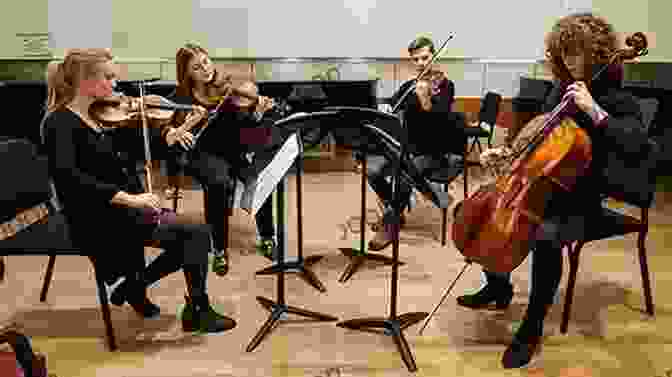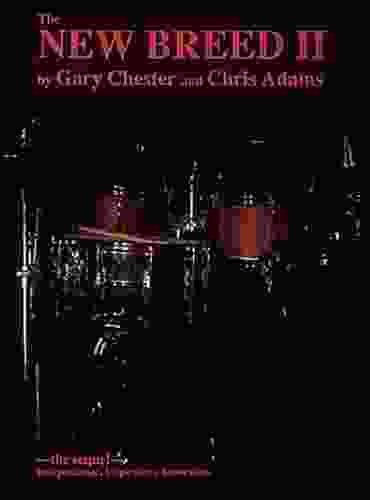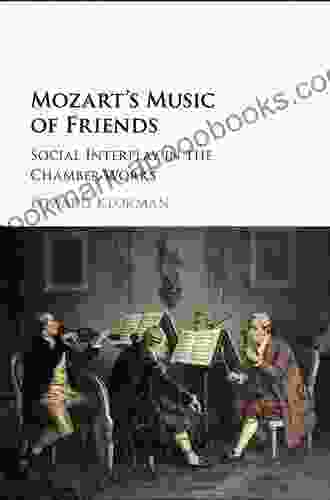Social Interplay in the Chamber Works: Unlocking the Dynamics of Musical Ensembles

Prologue: The Enchanting World of Chamber Music
Chamber music, an intimate and captivating form of musical expression, has captivated audiences for centuries. It invites us into a realm of intricate harmonies, expressive melodies, and nuanced rhythmic interplay. At its core lies a profound social dynamic, where musicians engage in a delicate dance of collaboration, communication, and shared interpretation.
In this extensive exploration, we embark on a journey into the social interplay that unfolds within chamber works. We delve into the historical and cultural contexts that have shaped these ensembles, examining how they have evolved over time. Our focus is on the intricate dynamics that govern musical expression, highlighting the unique contributions and challenges each musician faces in this collaborative art form.
5 out of 5
| Language | : | English |
| File size | : | 17503 KB |
| Text-to-Speech | : | Enabled |
| Enhanced typesetting | : | Enabled |
| Screen Reader | : | Supported |
| Print length | : | 357 pages |
Chapter 1: The Genesis of Chamber Music Ensembles
The origins of chamber music can be traced back to the Middle Ages, where small ensembles of instrumentalists and singers entertained at courtly gatherings. During the Renaissance and Baroque periods, these ensembles grew in popularity, playing a vital role in providing musical accompaniment for social events, religious ceremonies, and even theatrical productions.
Composers such as Corelli, Vivaldi, and Bach played a pivotal role in shaping the early chamber music repertoire. Their works showcased the expressive and technical possibilities of these smaller ensembles, laying the groundwork for the intricate interplay that would define the genre.
Chapter 2: The Classical Era and the Rise of Chamber Music
The Classical era witnessed a significant shift in the role and composition of chamber music. With the rise of the middle class and the establishment of public concert halls, it became a more accessible and popular form of entertainment. Composers such as Mozart, Haydn, and Beethoven elevated the genre to new heights, exploring its expressive and dramatic potential.
During this period, the piano emerged as a prominent member of chamber ensembles, adding a rich harmonic foundation and enabling a wider range of musical possibilities. The string quartet, featuring two violins, a viola, and a cello, also gained prominence, becoming a beloved and enduring ensemble format.
Chapter 3: The Romantic Era and the Expressive Revolution
The Romantic era brought a heightened focus on emotional expression and introspection in music. Chamber works became more personal and intimate, reflecting the composers' own experiences and inner worlds. Composers such as Schubert, Schumann, and Brahms explored the emotional depth and lyrical qualities of chamber music.
During this time, the piano trio, consisting of a piano, violin, and cello, emerged as a popular ensemble for exploring these expressive possibilities. The rich sonorities and emotional range of this combination captivated audiences and composers alike.
Chapter 4: The 20th Century and Beyond: Innovation and Experimentation
The 20th century saw a surge of innovation and experimentation in chamber music. Composers such as Stravinsky, Schoenberg, and Bartok pushed the boundaries of tonality, rhythm, and harmony. New ensemble configurations and instrumental combinations emerged, challenging traditional notions of chamber music.
This period witnessed the rise of wind quintets, brass ensembles, and mixed ensembles that combined instruments from different instrumental families. Composers explored extended techniques, unconventional harmonies, and experimental forms, expanding the expressive vocabulary of chamber music.
Chapter 5: The Dynamics of the Chamber Music Ensemble
At the heart of chamber music lies a unique set of social dynamics that govern musical expression and communication. Each musician within the ensemble plays an essential role in shaping the overall interpretation and performance.
Leaders emerge naturally, providing guidance and direction while ensuring that each voice is heard. Active listening is crucial, as musicians must be attuned to the nuances and subtleties of their fellow performers. Trust and mutual respect are essential for fostering a collaborative environment where individual strengths can shine through.
Chapter 6: Communication and Interpretation in Chamber Music
Communication within a chamber music ensemble extends beyond verbal cues. Musicians rely on a shared musical language, conveying their intentions through subtle gestures, eye contact, and body language. This nonverbal communication allows for a seamless flow of musical ideas and a unified interpretation.
The process of interpreting a chamber work involves a delicate balance between individual expression and collective agreement. Musicians must negotiate their own musical ideas while remaining open to the suggestions and perspectives of their fellow performers. This collaborative approach leads to a richer and more nuanced musical experience.
Epilogue: The Enduring Legacy of Chamber Music
Through its captivating history and evolving dynamics, chamber music has left an indelible mark on the musical landscape. It remains a vibrant and beloved art form, offering a unique blend of intimacy, collaboration, and expressive freedom.
As we continue to explore the intricate tapestry of chamber music, we unravel not only the beauty of musical interplay but also a testament to the power of human connection and the shared pursuit of artistic excellence.

5 out of 5
| Language | : | English |
| File size | : | 17503 KB |
| Text-to-Speech | : | Enabled |
| Enhanced typesetting | : | Enabled |
| Screen Reader | : | Supported |
| Print length | : | 357 pages |
Do you want to contribute by writing guest posts on this blog?
Please contact us and send us a resume of previous articles that you have written.
 Book
Book Novel
Novel Page
Page Chapter
Chapter Text
Text Story
Story Genre
Genre Reader
Reader Library
Library Paperback
Paperback E-book
E-book Magazine
Magazine Newspaper
Newspaper Paragraph
Paragraph Sentence
Sentence Bookmark
Bookmark Shelf
Shelf Glossary
Glossary Bibliography
Bibliography Foreword
Foreword Preface
Preface Synopsis
Synopsis Annotation
Annotation Footnote
Footnote Manuscript
Manuscript Scroll
Scroll Codex
Codex Tome
Tome Bestseller
Bestseller Classics
Classics Library card
Library card Narrative
Narrative Biography
Biography Autobiography
Autobiography Memoir
Memoir Reference
Reference Encyclopedia
Encyclopedia Eldon J Eisenach
Eldon J Eisenach R M Kinder
R M Kinder Joel C Rosenberg
Joel C Rosenberg Ronald Levinson
Ronald Levinson Richard Carlin
Richard Carlin Jerome J Mclaughlin
Jerome J Mclaughlin Woosen Ur
Woosen Ur Suellen Fried
Suellen Fried George Washington Plunkitt
George Washington Plunkitt Ed Sarath
Ed Sarath Hiro Ainana
Hiro Ainana E E Cummings
E E Cummings John Einarson
John Einarson Dr Guy Roberts
Dr Guy Roberts C G Eppinette
C G Eppinette Duncan Macmillan
Duncan Macmillan Valerie Jordan
Valerie Jordan John Berger
John Berger Dustin Hartley
Dustin Hartley Ed Sykes
Ed Sykes
Light bulbAdvertise smarter! Our strategic ad space ensures maximum exposure. Reserve your spot today!

 Truman CapoteEmbark on an Unforgettable Journey: Explore the Appalachian Trail in Georgia...
Truman CapoteEmbark on an Unforgettable Journey: Explore the Appalachian Trail in Georgia...
 Isaiah Powell30 Days Toward Healing Your Grief: A Compassionate Guide to Embarking on the...
Isaiah Powell30 Days Toward Healing Your Grief: A Compassionate Guide to Embarking on the... Charlie ScottFollow ·15.2k
Charlie ScottFollow ·15.2k Jeremy MitchellFollow ·11.3k
Jeremy MitchellFollow ·11.3k Juan ButlerFollow ·19.9k
Juan ButlerFollow ·19.9k Chase SimmonsFollow ·4k
Chase SimmonsFollow ·4k Robert ReedFollow ·9.5k
Robert ReedFollow ·9.5k Jayden CoxFollow ·5.4k
Jayden CoxFollow ·5.4k Evan SimmonsFollow ·6.1k
Evan SimmonsFollow ·6.1k Edward ReedFollow ·7.5k
Edward ReedFollow ·7.5k

 Eugene Powell
Eugene PowellFat Cat Stories: Level At Word Family - A Purrfect Start...
Introducing the 'At'...

 William Powell
William PowellUnveiling the Treasures of Russian Poetry: The Cambridge...
Immerse yourself in the...

 Roberto Bolaño
Roberto BolañoUnveiling the Treasures of Beowulf: A Guided Tour with...
: Delving into the...

 Foster Hayes
Foster HayesTransport, Climate Change and the City: Tackling Urban...
Transport is a major...

 Calvin Fisher
Calvin FisherHow To Make It In The Music Industry: The Ultimate Guide...
Are you an aspiring musician with...

 Rick Nelson
Rick NelsonUnveiling the Enigmatic World of Gary Chester's "The New...
Step into a World...
5 out of 5
| Language | : | English |
| File size | : | 17503 KB |
| Text-to-Speech | : | Enabled |
| Enhanced typesetting | : | Enabled |
| Screen Reader | : | Supported |
| Print length | : | 357 pages |








